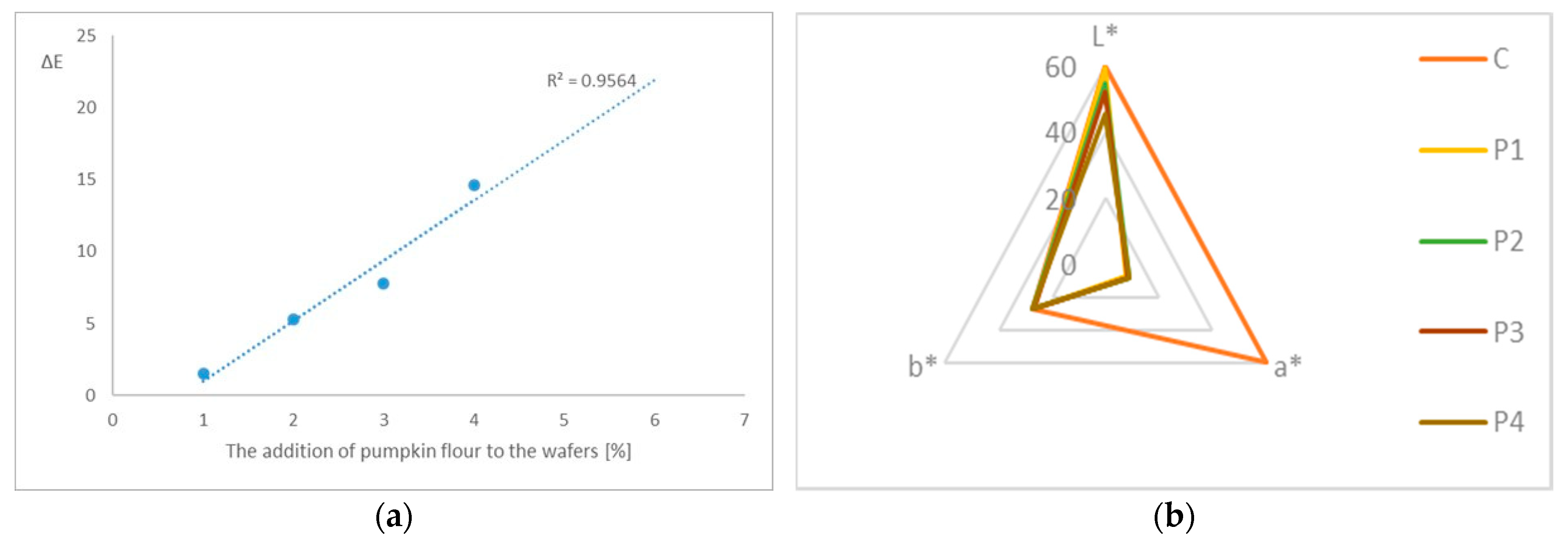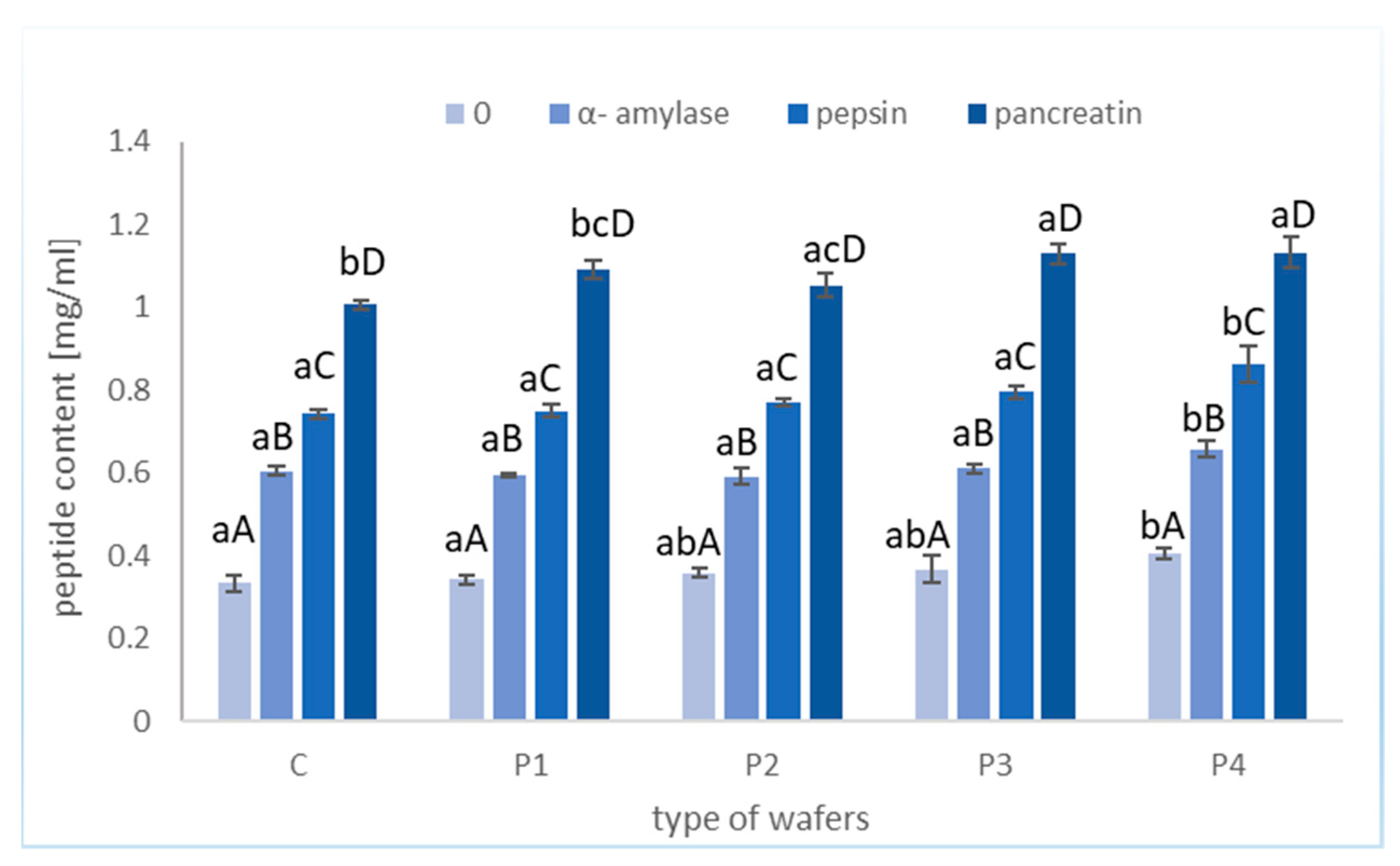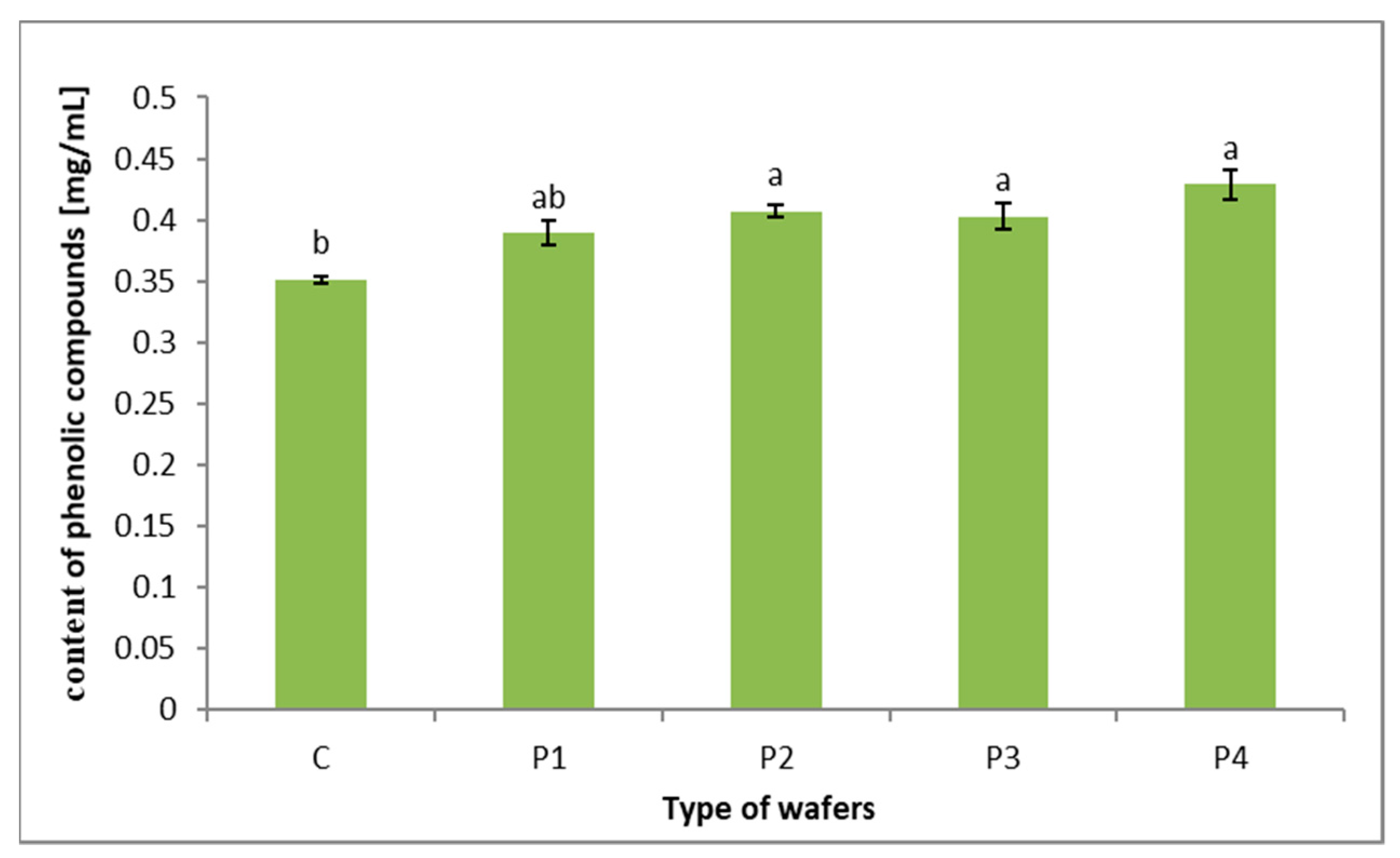Antioxidant Properties of Wafers with Added Pumpkin Seed Flour Subjected to In Vitro Digestion
Abstract
:1. Introduction
2. Materials and Methods
2.1. Research Material
2.2. The Consumer Evaluation
- Score 1—poor quality level;
- Score 2—insufficient quality level;
- Score 3—sufficient quality level;
- Score 4—good quality level;
- Score 5—very good quality level.
2.3. Determination of Physical Properties
2.3.1. Determination of Color Parameters
- The L* component indicates the brightness of the product;
- The a* component determines the color of the product ranging from green to red;
- The b* component determines the color of the product ranging from blue to yellow.
- L*, a*, and b* are color parameters of tested wafers;
- , , and are color parameters of control wafers.
2.3.2. Determination of Texture Profile
2.3.3. Functional Properties
Water Absorption Capacity (WAC)
- WAC—water absorption (%);
- W—weight (g);
- b—mass of the empty test tube (g);
- c—mass of the test tube with wet sediment (g).
Oil Absorption Capacity (OAC)
- OAC—oil absorption (%);
- W—weight (g);
- b—mass of the empty test tube (g);
- c—mass of the test tube with absorbed fat (g).
Foaming Efficiency and Foam Stability
- FS—foam stability (%);
- e—foam volume after 30 min (mL);
- f—total foam volume (mL).
2.4. In Vitro Hydrolysis
2.5. Peptide Content Determination
2.6. Total Phenolic Content Determination
2.7. Antioxidant Activity
2.7.1. Antiradical Activity against ABTS+•
2.7.2. Antiradical Activity against DPPH*
2.7.3. Fe2+ Chelating Ability
2.7.4. Reducing Power
2.8. Statistical Analysis
3. Results
3.1. The Consumer Evaluation and Physical Properties of Wafers
3.2. Bioactive Compound Content
3.3. Antioxidant Properties
4. Discussion
5. Conclusions
Supplementary Materials
Author Contributions
Funding
Institutional Review Board Statement
Informed Consent Statement
Data Availability Statement
Acknowledgments
Conflicts of Interest
References
- Żarnowski, A.; Jankowski, M.; Gujski, M. Public Awareness of Diet-Related Diseases and Dietary Risk Factors: A 2022 Nationwide Cross-Sectional Survey among Adults in Poland. Nutrients 2022, 14, 3285. [Google Scholar] [CrossRef]
- Available online: https://www.healthdata.org/research-analysis/health-risks-issues/diet (accessed on 15 May 2024).
- Whitworth, J. Pumpkin Seeds into Nanoparticles. Mod. Concepts Dev. Agron. 2022, 12, 1175–1177. [Google Scholar] [CrossRef]
- Singh, A.; Kumar, V. Pumpkin seeds as nutraceutical and functional food ingredient for future: A review. Grain Oil Sci. Technol. 2024, 7, 12–29. [Google Scholar] [CrossRef]
- Singh, A.; Kumar, V. Cultivars Effect on the Physical Characteristics of Pumpkin (Cucurbita moschata Duch.) Seeds and Kernels. J. Inst. Eng. Ser. A 2020, 101, 631–641. [Google Scholar] [CrossRef]
- Bieżanowska-Kopeć, R.; Ambroszczyk, A.M.; Piatkowska, E.; Leszczyńska, T. Nutritional Value and Antioxidant Activity of Fresh Pumpkin Flowers (Cucurbita sp.) Grown in Poland. Appl. Sci. 2022, 12, 6673. [Google Scholar] [CrossRef]
- Kar, S.; Dutta, S.; Yasmin, R. A comparative study on phytochemicals and antioxidant activity of different parts of pumpkin (Cucurbita maxima). Food Chem. Adv. 2023, 3, 100505. [Google Scholar] [CrossRef]
- Djuricic, I.; Calder, P.C. Beneficial outcomes of omega-6 and omega-3 polyunsaturated fatty acids on human health: An update for 2021. Nutrients 2021, 13, 2421. [Google Scholar] [CrossRef]
- Krimer-Malešević, V. Pumpkin Seeds: Phenolic Acids in Pumpkin Seed (Cucurbita pepo L.). In Nuts and Seeds in Health and Disease Prevention; Academic Press: Cambridge, MA, USA, 2020; pp. 533–542. [Google Scholar] [CrossRef]
- Hussain, A.; Kausar, T.; Din, A.; Murtaza, M.A.; Jamil, M.A.; Noreen, S.; Rehman, H.u.; Shabbir, H.; Ramzan, M.A. Determination of total phenolic, flavonoid, carotenoid, and mineral contents in peel, flesh, and seeds of pumpkin (Cucurbita maxima). J. Food Process. Preserv. 2021, 45, e15542. [Google Scholar] [CrossRef]
- Amin, M.Z.; Islam, T.; Uddin, M.R.; Uddin, M.J.; Rahman, M.M.; Satter, M.A. Comparative study on nutrient contents in the different parts of indigenous and hybrid varieties of pumpkin (Cucurbita maxima Linn.). Heliyon 2019, 5, e02462. [Google Scholar] [CrossRef]
- Ferreira Vieira, E.M. Bioactive peptides released from Cucurbitaceae seed proteins during gastrointestinal digestion. In Protein Digestion-Derived Peptides; Elsevier: Amsterdam, The Netherlands, 2024; pp. 305–333. [Google Scholar] [CrossRef]
- Lin, C.T.; Tejano, L.A.; Panjaitan, F.C.A.; Permata, V.N.S.; Sevi, T.; Chang, Y.W. Protein identification and potential bioactive peptides from pumpkin (Cucurbita maxima) seeds. Food Sci. Nutr. 2024, 1–15. [Google Scholar] [CrossRef]
- Dotto, J.M.; Chacha, J.S. The potential of pumpkin seeds as a functional food ingredient: A review: Biofunctional ingredients of pumpkin seeds. Sci. Afr. 2020, 10, e00575. [Google Scholar] [CrossRef]
- Sawarsathi, D.; Renu, R.; Maloo, S. Development and quality evaluation of pumpkin seeds and flaxseeds powder incorporated biscuits. Int. J. Food Sci. Nutr. 2018, 3, 78–83. [Google Scholar]
- Mdluli, H.; Kidane, S.W.; Nkambule, T.P.; Shelembe, J.S. Valorisation of pumpkin seeds through wheat-sorghum-pumpkin seed composite flour muffins: Optimization using D-optimal mixture design. Cogent Food Agric. 2024, 10, 2303833. [Google Scholar] [CrossRef]
- Adelerin, R.O.; Awolu, O.O.; Ifesan, B.O.T.; Nwaogu, M.U. Pumpkin-based cookies formulated from optimized pumpkin flour blends: Nutritional and antidiabetic potentials. Food Humanit. 2024, 2, 100215. [Google Scholar] [CrossRef]
- Oliveira, I.; Marinho, B.; Szymanowska, U.; Karas, M.; Vilela, A. Chemical and Sensory Properties of Waffles Supplemented with Almond Skins. Molecules 2023, 28, 5674. [Google Scholar] [CrossRef]
- Ekramian, H.; Saedi Asl, M.; Karimi, M.; Sheikholeslami, Z.; Pedram Nia, A. Comparison the effect of fruits extract with fungal protease on waffle quality. J. Food Sci. Technol. 2021, 58, 4766–4774. [Google Scholar] [CrossRef]
- Zielińska, E.; Karaś, M.; Baraniak, B. Comparison of functional properties of edible insects and protein preparations thereof. LWT Food Sci. Technol. 2018, 91, 168–174. [Google Scholar] [CrossRef]
- Durak, A.; Baraniak, B.; Jakubczyk, A.; Świeca, M. Biologically active peptides obtained by enzymatic hydrolysis of Adzuki bean seeds. Food Chem. 2013, 141, 2177–2183. [Google Scholar] [CrossRef]
- Karaś, M.; Baraniak, B.; Rybczy, K.; Jakubczyk, A. The influence of heat treatment of chickpea seeds on antioxidant and fibroblast growth-stimulating activity of peptide fractions obtained from proteins digested under simulated gastrointestinal conditions. Int. J. Food Sci. Technol. 2015, 50, 2097–2103. [Google Scholar] [CrossRef]
- Adler-Nissen, J. Determination of the Degree of Hydrolysis of Food Protein Hydrolysates by Trinitrobenzenesulfonic Acid. J. Agric. Food Chem. 1979, 27, 1256–1262. [Google Scholar] [CrossRef] [PubMed]
- Singleton, V.L.; Orthofer, R.; Lamuela-Raventós, R.M. [14] Analysis of total phenols and other oxidation substrates and antioxidants by means of folin-ciocalteu reagent. Methods Enzymol. 1999, 299, 152–178. [Google Scholar] [CrossRef]
- Re, R.; Pellegrini, N.; Proteggente, A.; Pannala, A.; Yang, M.; Rice-Evans, C. Antioxidant activity applying an improved ABTS radical cation decolorization assay. Free Radic. Biol. Med. 1999, 26, 1231–1237. [Google Scholar] [CrossRef]
- Brand-Williams, W.; Cuvelier, M.E.; Berset, C. Use of a free radical method to evaluate antioxidant activity. LWT Food Sci. Technol. 1995, 28, 25–30. [Google Scholar] [CrossRef]
- Decker, E.A.; Welch, B. Role of Ferritin as a Lipid Oxidation Catalyst in Muscle Food†. J. Agric. Food Chem. 1990, 38, 674–677. [Google Scholar] [CrossRef]
- Pulido, R.; Bravo, L.; Saura-Calixto, F. Antioxidant activity of dietary polyphenols as determined by a modified ferric reducing/antioxidant power assay. J. Agric. Food Chem. 2000, 48, 3396–3402. [Google Scholar] [CrossRef]
- Gupta, N.; Agarwal, M.; Bhatia, V.; Jha, S.K.; Dinesh, J. Invitro Antioxidant Activity of Crude Extracts of the Plant. Int. J. Pharm. Sci. Rev. Res. 2011, 6, 159–162. [Google Scholar]
- Weldeyohanis Gebremariam, F.; Tadesse Melaku, E.; Sundramurthy, V.P.; Woldemichael Woldemariam, H. Development of functional cookies form wheat-pumpkin seed based composite flour. Heliyon 2024, 10, e24443. [Google Scholar] [CrossRef]
- Alshehry, G.A. Preparation and Nutritional Properties of Cookies from the Partial Replacement of Wheat Flour Using Pumpkin Seeds Powder. World J. Environ. Biosci. 2020, 9, 48–56. Available online: www.environmentaljournals.org (accessed on 15 May 2024).
- Jakubczyk, A.; Ćwiek, P.; Rybczyńska-Tkaczyk, K.; Gawlik-Dziki, U.; Złotek, U. The influence of millet flour on antioxidant, anti-ACE, and anti-microbial activities of wheat wafers. Foods 2020, 9, 220. [Google Scholar] [CrossRef]
- Amigo, L.; Hernández-Ledesma, B. Current evidence on the bioavailability of food bioactive peptides. Molecules 2020, 25, 4479. [Google Scholar] [CrossRef]
- Langston, F.M.A.; Nash, G.R.; Bows, J.R. The retention and bioavailability of phytochemicals in the manufacturing of baked snacks. Crit. Rev. Food Sci. Nutr. 2023, 63, 2141–2177. [Google Scholar] [CrossRef] [PubMed]
- Rózyło, R.; Gawlik-Dziki, U.; Dziki, D.; Jakubczyk, A.; Karaś, M.; Rózylo, K. Wheat bread with pumpkin (Cucurbita maxima L.) pulp as a functional food product. Food Technol. Biotechnol. 2014, 52, 430–438. [Google Scholar] [CrossRef]
- Rezig, L.; Riaublanc, A.; Chouaibi, M.; Guéguen, J.; Hamdi, S. Functional Properties of Protein Fractions Obtained from Pumpkin (Cucurbita maxima) Seed. Int. J. Food Prop. 2016, 19, 172–186. [Google Scholar] [CrossRef]





| Overall Appearance | Characteristic, Highly Desirable Appearance of the Product |
|---|---|
| Surface | Uniform, smooth, clear pattern imprint |
| Color | Uniform, intense, clean |
| Taste | Distinctive, tasty |
| Smell | Distinctive, intense |
| Consistency (crispness, fragility) | Very crisp |
| Consistency (hardness) | Very hard |
| L* | a* | b* | ΔE | Hardness [g × sec] | Fracturability [g × sec] | |
|---|---|---|---|---|---|---|
| C | 59.73 ± 0.3 a | 8.93 ± 0.49 a | 27.24 ± 0.79 a | - | 1241 ± 248 a | 3570 ± 307 a |
| P1 | 59.27 ± 0.49 a | 7.55 ± 0.3 a | 26.87 ± 0.12 a | 1.50 | 962 ± 267 ab | 3190 ± 712 a |
| P2 | 54.46 ± 0.38 b | 8.79 ± 0.68 a | 27.19 ± 1.39 a | 5.27 | 954 ± 262 ab | 3687 ± 566 a |
| P3 | 52.03 ± 1.58 c | 8.19 ± 0.5 a | 26.67 ± 1.17 a | 7.76 | 968 ± 158 ab | 3505 ± 539 a |
| P4 | 45.12 ± 0.79 d | 8.56 ± 0.88 a | 27.14 ± 1.50 a | 14.62 | 1070 ± 349 ab | 4155 ± 634 a |
| C | P1 | P2 | P3 | P4 | |
|---|---|---|---|---|---|
| FS [%] | - | - | - | - | - |
| FC [mL] | 1.0 | 1.2 | 1.6 | 1.7 | 2.0 |
| WAC [%] | 586.3 ± 9.192 a | 566.5 ± 2.121 a | 561 ± 46.67 a | 552.5 ± 4.949 a | 549.5 ± 47.38 a |
| OAC [%] | 397.6 ± 4.04 a | 398 ± 5.66 a | 407 ± 15.56 a | 411 ± 5.66 a | 403 ± 4.24 a |
| Hydrolysate Samples | Antioxidant Properties | |||
|---|---|---|---|---|
| ABTS*+ [IC50 mg/mL] | DPPH* [IC50 mg/mL] | Fe2+ Chelation [IC50 mg/mL] | Reducing Power [µmol Trolox/mL] | |
| C | 4.452 ± 0.080 c | 83.08 ± 9.968 c | 2.222 ± 0.133 a | 2.493 ± 0.086 c |
| P1 | 4.449 ± 0.099 b | 90.39 ± 7.382 bc | 2.105 ± 0.105 a | 2.591 ± 0.067 bc |
| P2 | 3.240 ± 0.100 b | 90.21 ± 3.475 c | 2.083 ± 0.115 a | 2.811 ± 0.059 ab |
| P3 | 2.983 ± 0.073 b | 69.59 ± 6.727 b | 2.062 ± 0.113 a | 2.855 ± 0.206 ab |
| P4 | 2.653 ± 0.026 a | 53.86 ± 2.603 a | 2.041 ± 0.100 a | 3.033 ± 0.081 a |
| ≤3.5 kDa Fraction Samples | Antioxidant Properties | |||
|---|---|---|---|---|
| ABTS*+ [IC50 mg/mL] | DPPH* [IC50 mg/mL] | Fe2+ Chelation [IC50 mg/mL] | Reducing Power [µmol Trolox/mL] | |
| Cf | 0.523 ± 0.018 a | 5.583 ± 0.846 b | 0.245 ± 0.041 c | 0.030 ± 0.002 a |
| Pf1 | 0.513 ± 0.021 a | 5.986 ± 0.907 b | 0.157 ± 0.028 ab | 0.029 ± 0.001 a |
| Pf2 | 0.512 ± 0.056 a | 5.123 ± 0.388 b | 0.192 ± 0.037 b | 0.028 ± 0.002 a |
| Pf3 | 0.507 ± 0.036 a | 4.118 ± 0.281 ab | 0.190 ± 0.028 b | 0.028 ± 0.002 a |
| Pf4 | 0.491 ± 0.037 a | 3.843 ± 0.291 a | 0.114 ± 0.015 ab | 0.028 ± 0.001 a |
Disclaimer/Publisher’s Note: The statements, opinions and data contained in all publications are solely those of the individual author(s) and contributor(s) and not of MDPI and/or the editor(s). MDPI and/or the editor(s) disclaim responsibility for any injury to people or property resulting from any ideas, methods, instructions or products referred to in the content. |
© 2024 by the authors. Licensee MDPI, Basel, Switzerland. This article is an open access article distributed under the terms and conditions of the Creative Commons Attribution (CC BY) license (https://creativecommons.org/licenses/by/4.0/).
Share and Cite
Karaś, M.; Szymanowska, U.; Borecka, M.; Jakubczyk, A.; Kowalczyk, D. Antioxidant Properties of Wafers with Added Pumpkin Seed Flour Subjected to In Vitro Digestion. Appl. Sci. 2024, 14, 5129. https://doi.org/10.3390/app14125129
Karaś M, Szymanowska U, Borecka M, Jakubczyk A, Kowalczyk D. Antioxidant Properties of Wafers with Added Pumpkin Seed Flour Subjected to In Vitro Digestion. Applied Sciences. 2024; 14(12):5129. https://doi.org/10.3390/app14125129
Chicago/Turabian StyleKaraś, Monika, Urszula Szymanowska, Magdalena Borecka, Anna Jakubczyk, and Dariusz Kowalczyk. 2024. "Antioxidant Properties of Wafers with Added Pumpkin Seed Flour Subjected to In Vitro Digestion" Applied Sciences 14, no. 12: 5129. https://doi.org/10.3390/app14125129








